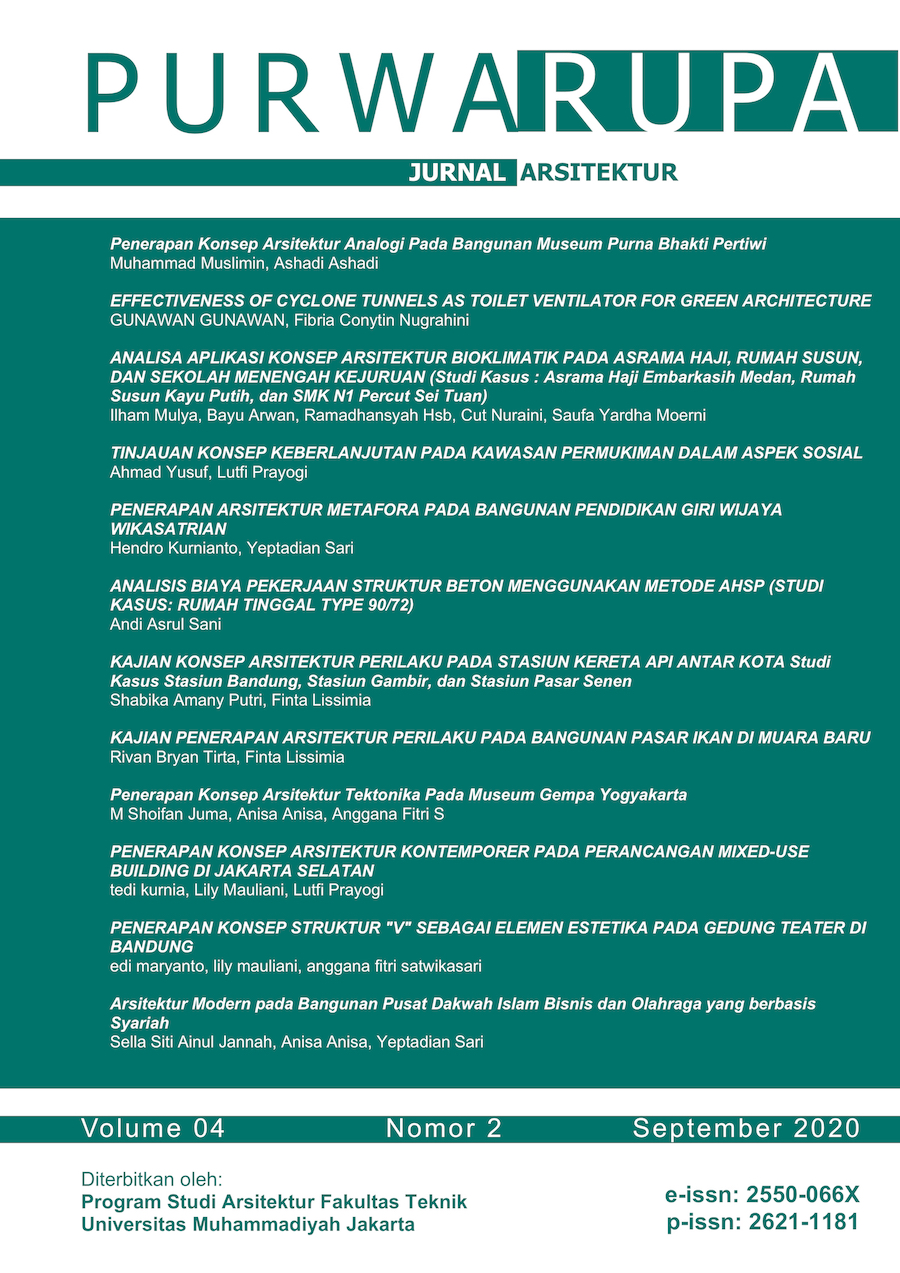EFFECTIVENESS OF CYCLONE TUNNELS AS TOILET VENTILATOR FOR GREEN ARCHITECTURE
DOI:
https://doi.org/10.24853/purwarupa.4.2.7-12Abstract
Abstract.Highest usage of energy to the air condition will be ever accompanied by the increasing of Glass house Gas productivity, owning flimsy impact of Ozone coat in Atmosphere. Really this phenomenon in future will be more concern, the important thing in city area that loaded high rise building. For that to all architects along with their stakeholder who required doing the effort accompanied with variety of innovation and also creation that based on action of energy economically. Existence of Structure System of Core at laminated building of many floors (high rise building) where the shape was looked like flue roof boosting to follow height of building, can be processed and dimulty functioned as component of natural evaporation system by giving addition some elements among others, mow (duct) vertical - horizontal, room or funnel for cross section of temporary air, baling-baling (cyclone) and grill. With this natural evaporation method, the assumption can do to transfer of air at least at restroom or toilet area at high rise. Functionalism of core was as flue of natural evaporation meant as adding effort on exchequer of Green Architecture. Keyword: economical of energy, gas of glass house, green architecture AbstrakSemakin tingginya penggunaan energi untuk pengkondisian udara, akan senantiasa diiringi oleh meningkatnya produktivitas Gas Rumah Kaca, yang memiliki dampak menipisnya lapisan Ozon di Atmosfir. Sungguh fenomena ini kedepan akan semakin memprihatinkan, utamanya di kawasan perkotaan yang sarat bangunan tinggi. Untuk itu bagi para arsitek beserta steakholder-nya perlu melakukan upaya yang diiringi dengan ragam inovasi serta kreasi yang berbasis pada tindakan hemat energi. Keberadaan Sistem Struktur Core pada bangunan berlapis lantai banyak ( high rise building) dimana bentuknya telah menyerupai bumbung cerobong yang menjulang mengikuti ketinggian bangunan, dapat diolah dan dimulti fungsikan sebagai komponen Sistem penghawaan alamiah dengan memberikan tambahan beberapa elemen diantaranya, selumbung (duct) vertikal – horizontal, ruang atau corong penampung udara sementara, bailng-baling (cyclone) dan kisi-kisi (grill). Dengan metoda penghawaan alamiah ini, diasumsi dapat melakukan pertukaran udara sedikitnya pada area lantai dasar untuk gedung empat lantai keatas. Fungsionalisasi core sebagai cerobong penghawaan alamiah dimaksudkan sebagai upaya penambah perbendaharaan Green Architecture. Kata kunci: Arsitektur hijau, Gas rumah kaca, Hemat energiReferences
Hervé Pabiou, Julien Salort, Christophe Ménézo, Francesca Chillà “Natural cross-ventilation of buildings, an experimental study” 6th International Building Physics Conference, IBPC 2919 (2015).
Santoso, Mas. Climatic Design for Warm Humid Climates. “Proceeding Tropical Architecture Workshop “. Editor : R. Aynsley, (1993).
Lippsmeir, Georg. Tropenbau Building in the Tropics. Verlag Georg DW Callway. Munchen. (1989).
Gunawan, Arifin MS. Rumah Bercerobong sebagai Upaya Optimalisasi Ventilasi Silang “Prosiding Seminar Nasional. Teknologi Ramah Lingkungan dalam Pembangunan Berkelanjutan” (Fakultas Teknik Sipil dan Perencanaan. Institut Teknologi Nasional Malang. (2010).
Santoso, Mas. Environmental Factors in Traditional Environment. Rethingking Environmentally Responsible Architecture, A Case of Traditional Architecture in the Tropic of Indonesia. Editor : Nezar Al Sayyad. (International Association for the study of Traditional Environments) University of California. Berkley. (1996).
Xiao-Yu Maa, Yue Penga, Fu-Yun Zhaoa, Cheng-Wei Liua, Shuo-Jun Mei, Full Numerical Investigations on the Wind Driven Natural Ventilation: Cross Ventilation and Single-sided Ventilation. 10th International Symposium on Heating, Ventilation and Air Conditioning, ISHVAC2017, (2017), p. 3803.
Frick, Heinz dan Mulyani, Tri Hesti. Arsitektur Ekologis (Kanisius, Yogyakarta, 2006), p. 78.
Downloads
Published
How to Cite
Issue
Section
License
COPYRIGHT POLICY
The author(s) of an article published in the Jurnal Teknologi retains ownership of the intellectual property rights in work (s).
PUBLISHING RIGHTS
The author(s) of an article published in the Jurnal Teknologi have unrestricted publication rights. The authors give the Jurnal Teknologi the right to publish the article and designate the Faculty of Engineering Universitas Muhammadiyah Jakarta Publishing as the original publisher of the article.
LICENSING POLICY
Journal of Mechanical Engineering and Sciences is an open-access journal that follows the Creative Commons Non-Commercial 4.0 International License (CC BY-NC 4.0), which states that:

Under this license, the reusers must give appropriate credit, provide a link to the license, and indicate if changes were made. Users may do so in any reasonable manner, but not in any way that suggests the licensor endorses users or their use.
Please take the time to read the whole license agreement (https://creativecommons.org/licenses/by-nc/4.0/). As long as reusers follow the license conditions, the owner cannot withdraw these freedoms. The following components are included under this license:
 Attribution: Users must provide appropriate attribution, including a link to the license, and indicate whether or not they made any modifications. Users are free to do so reasonably, but not in a manner that indicates the licensee approves of their usage.
Attribution: Users must provide appropriate attribution, including a link to the license, and indicate whether or not they made any modifications. Users are free to do so reasonably, but not in a manner that indicates the licensee approves of their usage.
 NonCommercial: Users may not use the material for commercial purposes.
NonCommercial: Users may not use the material for commercial purposes.

